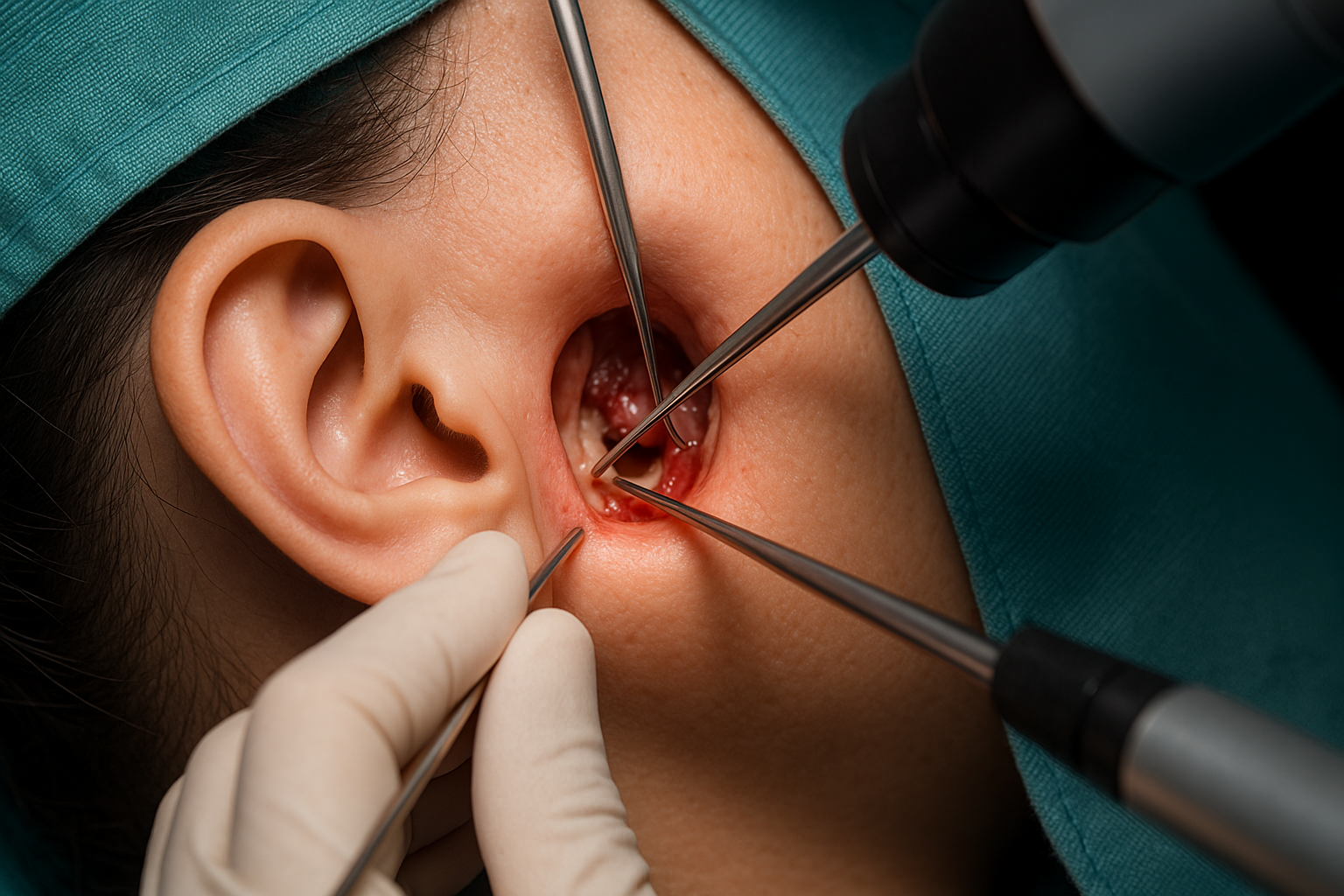Persistent ear discharge, hearing loss, and discomfort are not just minor inconveniences—they may be signs of a serious ear condition known as Chronic Suppurative Otitis Media (CSOM). This chronic infection of the middle ear can significantly affect a person’s quality of life and, if left untreated, can lead to complications such as hearing impairment and damage to ear structures.
At Dr. Ram ENT Hospital, we specialize in the diagnosis and surgical treatment of Chronic Suppurative Otitis Media through advanced Chronic Suppurative Otitis Media Surgery, providing advanced care tailored to each patient’s condition and needs.
What is Chronic Suppurative Otitis Media (CSOM)?
Chronic Suppurative Otitis Media is a long-standing infection of the middle ear and mastoid cavity characterized by continuous or recurrent ear discharge through a perforated eardrum. Unlike acute otitis media, which resolves within days or weeks, CSOM persists over months and requires more targeted intervention.
Chronic Suppurative Otitis Media Types
There are generally two clinical types of chronic suppurative otitis media:
1. Tubotympanic Type (Safe Type):
Involves the central part of the eardrum and is less likely to cause severe complications. It often leads to intermittent, mucopurulent discharge and conductive hearing loss.
2. Atticoantral Type (Unsafe Type):
Involves the upper part of the ear and is frequently associated with cholesteatoma (a skin growth in the middle ear). This type is more dangerous due to its potential for serious complications such as bone erosion, facial nerve damage, and brain infections.
Common Chronic Suppurative Otitis Media Symptoms
CSOM can vary in severity, but common chronic suppurative otitis media symptoms include:
- Persistent or recurring ear discharge (otorrhea)
- Hearing loss (often conductive)
- A feeling of fullness in the ear
- Tinnitus (ringing in the ears)
- Occasionally, dizziness or vertigo
- Foul-smelling discharge (especially in atticoantral type)
If you or your child experiences these symptoms for more than a few weeks, it’s essential to seek medical evaluation from an ENT specialist.
When is Chronic Suppurative Otitis Media Surgery Required?
In many cases, medical treatment such as antibiotics and aural toilet (ear cleaning) can manage symptoms. However, when the condition persists, worsens, or causes structural damage to the middle ear, CSOM surgery becomes necessary.
Indications for surgery include:
- Persistent ear discharge despite medical treatment
- Large or non-healing perforation in the eardrum
- Hearing loss due to ossicular erosion
- Presence of cholesteatoma
- Recurrent infections with complications
Types of CSOM Surgery
The specific surgical procedure depends on the type and extent of the infection. Common Chronic Suppurative Otitis Media surgeries include:
1. Myringoplasty (Eardrum Repair):
Performed to close a perforated eardrum and improve hearing.
2. Tympanoplasty:
A more comprehensive surgery that involves repairing the eardrum and reconstructing the ossicular chain (middle ear bones) if necessary.
3. Mastoidectomy:
Involves removal of infected mastoid air cells and is often required in atticoantral type CSOM or when cholesteatoma is present.
4. Modified Radical Mastoidectomy:
This is a more extensive procedure aimed at clearing out all diseased tissue, especially in complex or unsafe types of CSOM.
At Dr. Ram ENT Hospital, we perform all types of CSOM surgeries using high-precision microsurgical techniques and modern equipment to ensure optimal recovery and minimal complications.
Post-Surgical Care and Recovery
Recovery from Chronic Suppurative Otitis Media Surgery is generally smooth when post-operative instructions are followed properly. Some key aspects include:
- Avoid water entering the ear during the healing phase
- Take prescribed antibiotics and medications as advised
- Attend regular follow-up appointments for cleaning and monitoring
- Avoid blowing your nose forcefully during the first few weeks
Hearing improvement may take time, especially if there was damage to middle ear structures, but most patients experience significant relief from discharge and infections.
Frequently Asked Questions (FAQs)
Q1: Is CSOM surgery painful?
The surgery itself is performed under general or local anesthesia, so there is no pain during the procedure. Some mild discomfort may be felt during recovery, which is manageable with prescribed medication.
Q2: How long does CSOM surgery take?
The duration varies depending on the procedure but typically ranges between 1 to 3 hours.
Q3: Will I regain my hearing after CSOM surgery?
Most patients notice improvement in hearing, especially if the ossicular chain is intact or reconstructed successfully. However, outcomes depend on the severity and type of CSOM.
Q4: Is it possible for the condition to recur after surgery?
While surgery significantly reduces the risk of recurrence, proper post-surgical care and ear hygiene are important to prevent reinfection.
Q5: At what age can children undergo CSOM surgery?
Children with chronic symptoms unresponsive to medical treatment may be considered for surgery as young as 6–7 years, depending on their health and condition severity.
Final Thoughts
Chronic Suppurative Otitis Media is more than just an ear infection — it’s a condition that can impact hearing, speech development (especially in children), and overall quality of life if not treated properly. Surgery remains a safe and effective option for long-term relief and functional restoration.
At Dr. Ram ENT Hospital, we bring years of specialized experience in diagnosing and treating CSOM with the most advanced surgical techniques available. Our goal is to ensure every patient receives the care they need for a healthier, infection-free future.
If you or a loved one is experiencing signs of chronic ear infections, don’t delay. Schedule a consultation today and take the first step toward expert ENT care and lasting relief.



